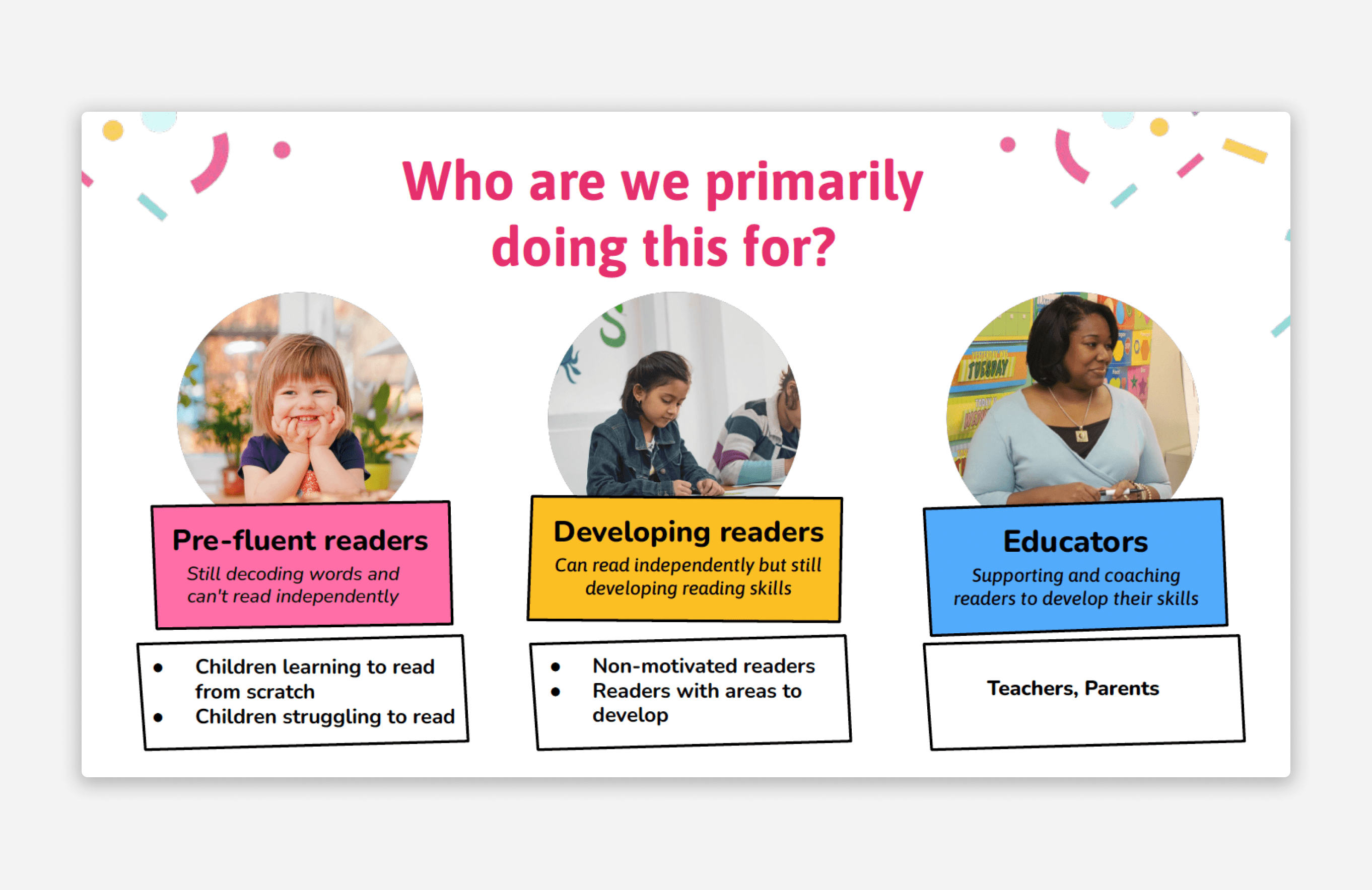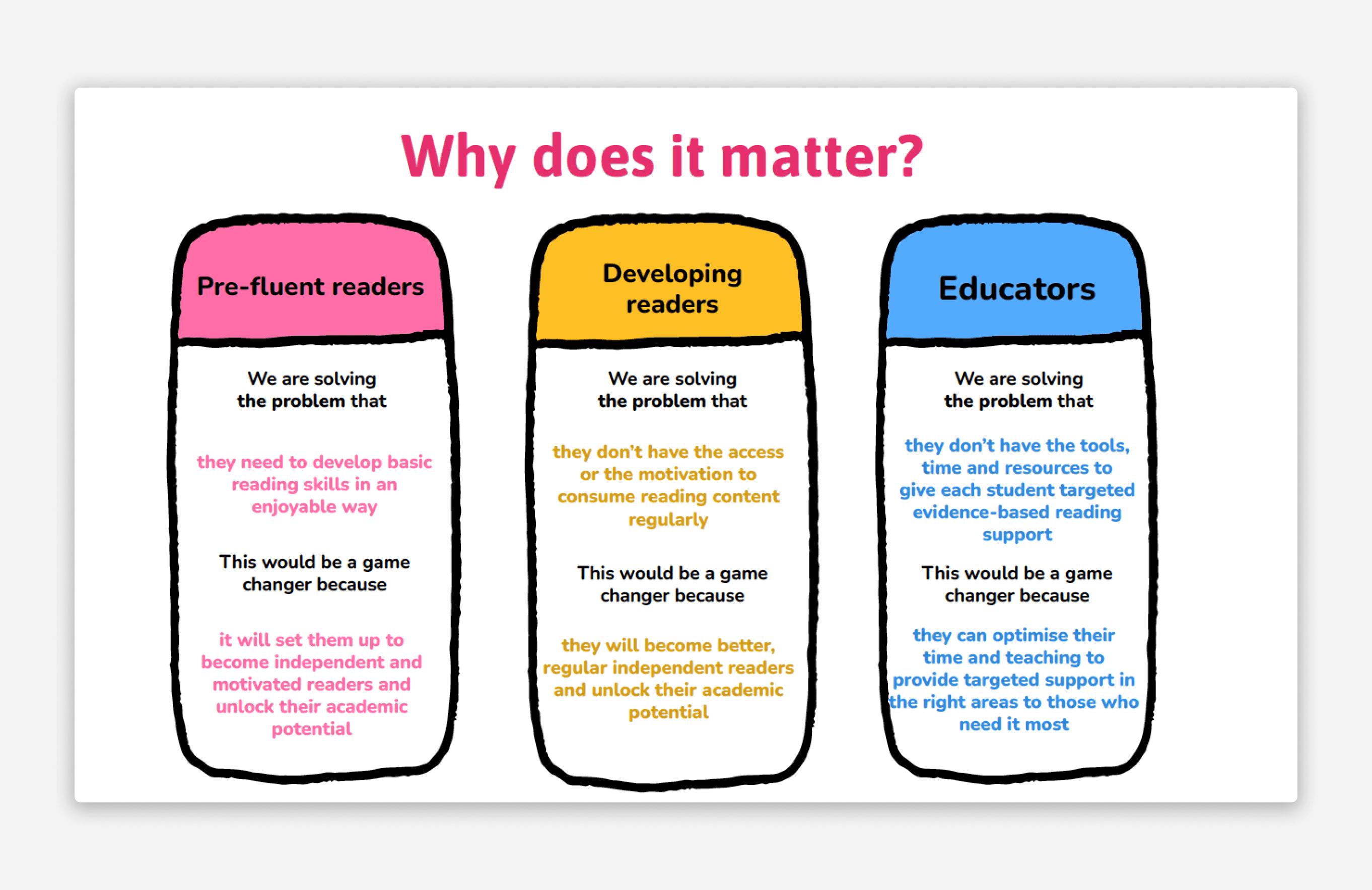Setting the stage for success within an ed tech startup
Pickatale is a Norwegian ed-tech start up which was launched in 2014. The goal of Pickatale as a start up was to focus on creating an engaging reading app for children throughout Western Europe - something that could be used both within the context of home and school.
But after a few years, the C-Suite had passed through many different management hands and ultimately still lacked an important element for success: our product vision, and strategy of how we were going to achieve this product vision.
Company
Pickatale
Timeframe
Nov - Dec 2021
Role
Lead Product Designer
Industry
EdTech
Background
When I joined Pickatale in September 2021, it felt like the start up was just going through a constant onslaught of fire fighting. The struggle to just get a viable app that had passed through multiple design and development teams was a mess, and once we had sorted out the code issues of the app for basic functionality - the question that we had was…what is this, and what do we envision the future looks like with this product?
How might we create a product vision that provides direction not just for the immediate future, but provides long term direction?
Getting started
We started to feel more confident about kicking off questioning and starting our product vision in November, after our other Senior Project Manager had joined the team. By this point, most of the product and tech team was between 2-3 months into their job, so we were all fairly new but more familiar with the product and the lack of structure within the company.
Understanding what we wanted as a company and from our product experience
We needed to take a step back from our product roadmap which was full of things we wanted to do - and really think about who really needed our product at the end of the day, and how we were helping them solve their problems.
During this time, it was really important to bounce ideas off of our in-house pedagogy expert to understand what kind of needs children from different age groups experience as they go through their literacy journey. It was also important that we reflect on our research with teachers, and understand how our product had helped them so far (if at all) and consider their core needs as we continue to evolve Pickatale. Parents are also an important user group, but our main target audience for constant usage is children and teachers - and this is the direction we envisioned Pickatale to continue towards.
Keeping communication going with our sales team as well was really important for this product vision strategy, since the sales team were constantly talking to users at this point and visiting in schools to see how our product was helping primary schools across the UK and Scandinavia achieve their goals for confident readers.
Defining who our product vision, and why
Between myself, product owners, our CTO, CEO, the Head of Sales and Head of Pedagogy - we held several meetings and Miro sessions to bash out not only who our vision should really focus on, but who and why. We also wanted to make sure we outlined what exactly we aimed to help our users with for the long term, because we felt it was important to be very clear about this when the time came to share this vision with the rest of the company.
This was pretty difficult but we had to strive to be very high level to outline outcomes that we felt we could see our product achieving in the long run. We wanted to avoid being too specific, or pigeonholing ourselves.
Sharing the strategy
After about a month of meetings and numerous Miro board sessions, we aimed to have our product strategy done and ready to share by the end of 2021. As a product and tech team, we wanted to make sure that we were clear not only about who we were helping, why and what we wanted to do - but also how we were going going to address our financial strategy of monetisation. Pickatale was not bringing in a profit despite its popularity with schools, because the schools that had adopted to using it so far were thrilled that Pickatale was free.
We still want Pickatale to be free for schools - but for private schools we wanted to figure out how we could monetise their relationship with us. We also wanted to keep in mind that if we continued to push the experience of the app for children in schools, there was a possibility that children will want to have access to more premium books or brands in our app, which we could capitalise on.
The reception to our strategy for both overall vision and monetisation was well received, but there was obvious concern about how we were going to achieve these big dreams in more realistic terms.
Setting our OKRs
Creating OKRs for the first time for the product and tech departments was also pretty daunting, but we wanted to see how we could start breaking down our product vision into achievable chunks. For Q1 2022, I had set OKRs for the UX team, and the product owners had set OKRs for the dev teams. However, what I learned from this was that having less OKRs that are more succinct is far better than having too many OKRs - particularly between different teams that share common goals.




